
Browse an alphabetical list of photographs. These historical images portray people, places, and events before, during, and after World War II and the Holocaust.
<< Previous | Displaying results 151-200 of 2641 for "Photo" | Next >>
False identification papers used by Adolf Eichmann while he was living in Argentina under the assumed name Ricardo Klement.
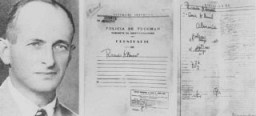
Adolf Hitler addresses an SA rally. Dortmund, Germany, 1933.
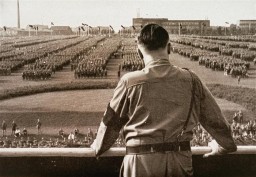
Germans cheer Adolf Hitler as he leaves the Hotel Kaiserhof just after being sworn in as chancellor. Berlin, Germany, January 30, 1933.
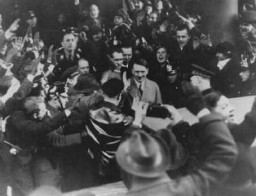
Followed closely by an SS bodyguard, Adolf Hitler greets supporters at the fourth Nazi Party Congress in Nuremberg. Germany, August 1929. US Holocaust Memorial Museum, courtesy of William O. McWorkman
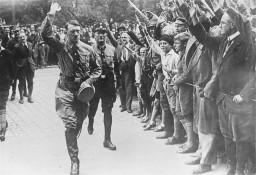
Adolf Hitler (center) with (from left to right): Heinz Riefenstahl, Frau Dr. Ebersberg, Leni Riefenstahl, Joseph Goebbels, and Ilse Riefenstahl. Germany, date uncertain.
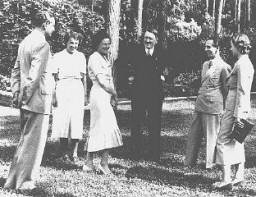
Saluting Germans greet Adolf Hitler (standing at front of car) as he enters Danzig. The Danzig District was incorporated into Greater Germany following the invasion of Poland. Danzig, September 19, 1939.

Adolf Hitler, the newly appointed chancellor, greets German president Paul von Hindenburg. Berlin, Germany, January 30, 1933.
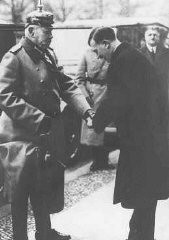
Recently appointed as German chancellor, Adolf Hitler greets President Paul von Hindenburg in Potsdam, Germany, on March 21, 1933. This pose was designed to project an image of Hitler as non-threatening to the established order. This particular image is from a popular postcard. The photo also appeared widely in both the German and international press. Hitler appears in civilian dress, bowing in deference to the heavily decorated von Hindenburg. The March 5, 1933, elections had conferred legitimacy on…
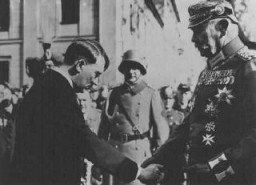
Adolf Hitler greets Reich Bishop Ludwig Mueller at a Nazi Party Congress. Roman Catholic Abbot Alban Schachleiter stands between Hitler and Mueller. Nuremberg, Germany, September 1934.
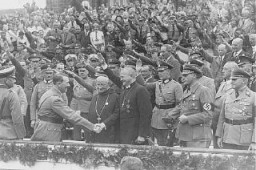
A crowd of saluting Germans surrounds Adolf Hitler's car as he leaves the Reich Chancellery following a meeting with President Paul von Hindenburg. Berlin, Germany, November 19, 1932.
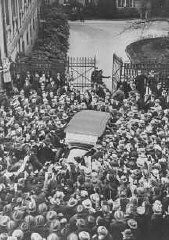
On the day of his appointment as German chancellor, Adolf Hitler greets a crowd of enthusiastic Germans from a window in the Chancellery building. Berlin, Germany, January 30, 1933.
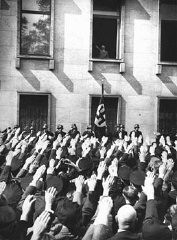
Adolf Hitler passes through the Brandenburg Gate on the way to the opening ceremonies of the Olympic Games. Berlin, Germany, August 1, 1936.
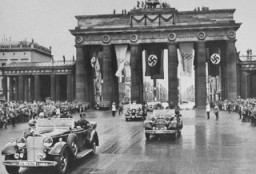
Adolf Hitler reviews his troops at Prague castle on the day of the occupation. Prague, Czechoslovakia, March 15, 1939.
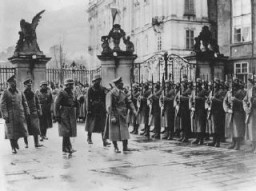
Adolf Hitler (lower right) gives Nazi salute as he reviews victorious German troops. Warsaw, Poland, October 5, 1939.
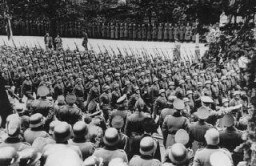
Standing in an open car, Adolf Hitler salutes a crowd in Hamburg, Germany. Photo dated August 17, 1934.
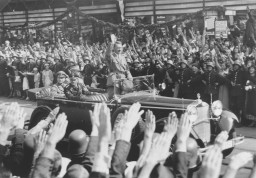
Adolf Hitler salutes a passing SS formation at the third Nazi Party Congress in 1927. Nuremberg, Germany, August 1927. The SS (Schutzstaffel, or Protection Squads) was originally established as Adolf Hitler’s personal bodyguard unit. It would later become both the elite guard of the Nazi Reich and Hitler’s executive force prepared to carry out all security-related duties, without regard for legal restraint.
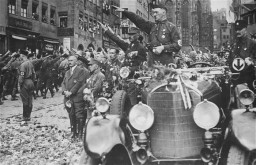
Hitler salutes the youth ranks at the Nazi Party Congress. Nuremberg, Germany, September, 1935.
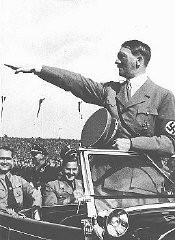
Adolf Hitler stands with an SA unit during a Nazi parade in Weimar, where the constitution of the Weimar Republic was drafted in 1919. Weimar, Germany, 1931.
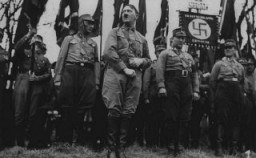
Adolf Hitler (center) walks and converses with other Nazi officials, date unknown.
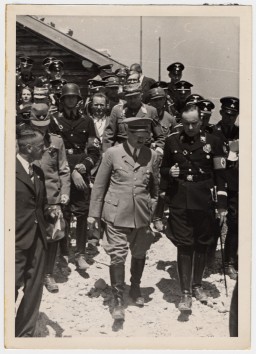
Adolf Hitler (front row, far left) served on the western front in World War I and during the course of the war was twice decorated for service, wounded, and temporarily blinded in a mustard gas attack. He used his veteran status in later election campaigns.
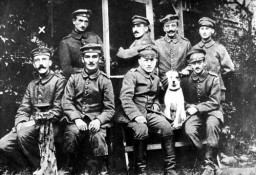
Adolf Hitler poses with his cabinet shortly after assuming power as chancellor of Germany. Hitler is flanked by Joseph Goebbels (left) and Hermann Göring (right). Berlin, Germany, 1933.
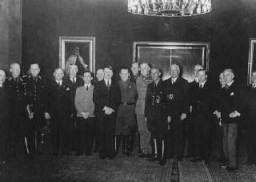
Adolf Hitler stands with his military high command at an inspection of German armed forces. From left to right: Hitler, Hermann Göring, Werner von Blomberg (armed forces), Erich von Fritsch (army) and Erich Raeder (navy). Germany, 1935.
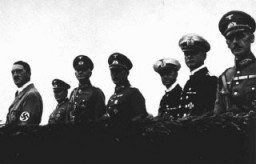
Adolf Hitler's authorization for the Euthanasia Program (Operation T4), signed in October 1939 but dated September 1, 1939.
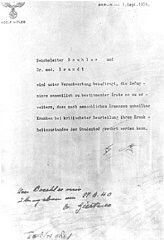
An advertisement for a series of lectures by Varian Fry, who worked in France to help anti-Nazi artists and intellectuals escape to the United States. New York, United States, 1942.
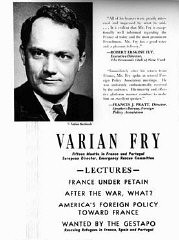
Advertising poster for the antisemitic film, Der ewige Jude (The Eternal Jew), directed by Fritz Hippler. Germany, ca. 1940.
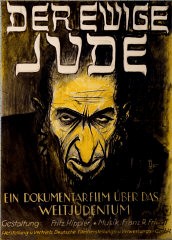
Aerial photograph of the Auschwitz III (Monowitz) camp, which was adjacent to the I.G. Farben plant. The photograph was taken following US bombing missions. Poland, January 14, 1945.
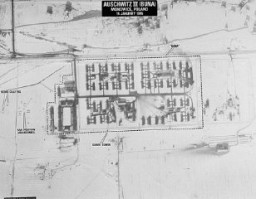
Aerial photograph of Auschwitz II (Birkenau). Poland, December 21, 1944. This image is one of a series of aerial photographs taken by Allied reconnaissance units under the command of the 15th US Army Air Force during missions dating between April 4, 1944, and January 14, 1945.
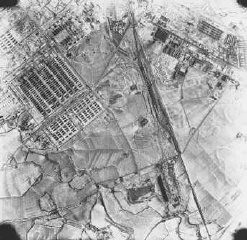
An aerial photograph of Babi Yar taken by the German air force. September 26, 1943.
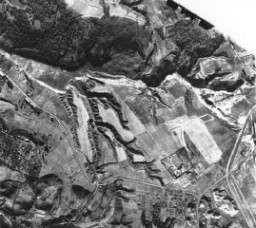
An aerial photograph of Babi Yar taken by the German air force. September 26, 1943.
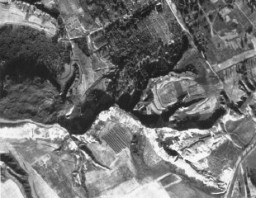
Aerial photograph showing the gas chambers and crematoria 2 and 3 at the Auschwitz-Birkenau (Auschwitz II) killing center. Auschwitz, Poland, August 25, 1944.
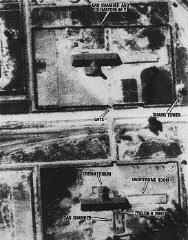
Aerial view of the Nuremberg Palace of Justice, where the International Military Tribunal tried 22 leading German officials for war crimes. Nuremberg, Germany, November 1945.
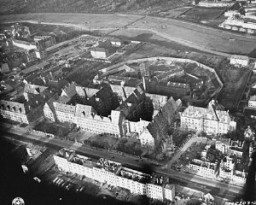
An aerial view of the Nuremberg prison, where defendants in the International Military Tribunal war crimes trial were held. Photograph taken in Nuremberg, Germany, between October 1945 and October 1946.
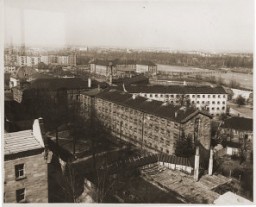
Erwin Rommel (center), German commander of the Africa Corps, at an airfield in Libya during an Axis offensive into neighboring Egypt. British troops decisively defeated Rommel's forces at El Alamein. Libya, September 8, 1942.
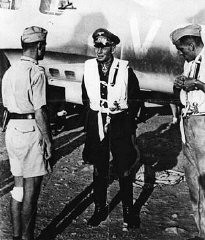
African American soldier Warren Capers was recommended for a Silver Star for his actions during the Allied invasion of France. He and his medical detachment aided more than 330 soldiers. France, August 18, 1944.
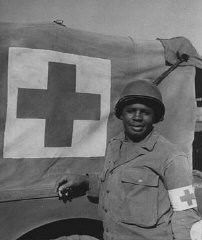
Members of the 12th Armored Division, which included African American platoons, await their orders. Germany, April 1945.
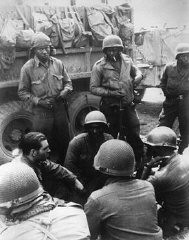
African American soldiers pose next to an oven in the crematorium of the Ebensee concentration camp.
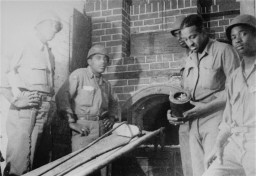
Crowd views the aftermath of a massacre at Lietukis Garage, where pro-German Lithuanian nationalists killed more than 50 Jewish men. The victims were beaten, hosed, and then murdered with iron bars. Kovno, Lithuania, June 27, 1941.
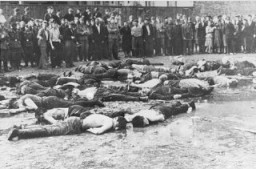
Police force Romanian Jews, survivors of a pogrom in Iasi, to board a train during their expulsion from Iasi to Calarasi. Iasi, Romania, late June 1941.
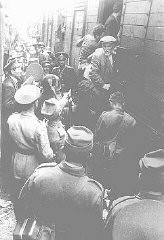
During the deportation of survivors of a pogrom in Iasi to Calarasi or Podul Iloaei, Romanians halt a train to throw off the bodies of those who had died on the way. Romania, July 1941.
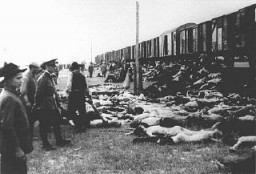
This photograph shows the aftermath of a shooting along the banks of the Danube River in Budapest. Members of the pro-German Arrow Cross party massacred thousands of Jews along the banks of the Danube. Budapest, Hungary, 1944.
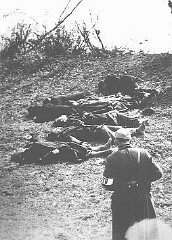
Concentration camp prisoners, many from satellite camps of Neuengamme, remove corpses of German civilians after Allied bombings of Hamburg. Germany, August 1943.
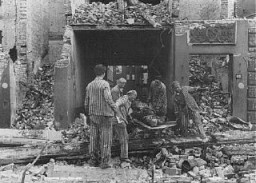
Roma (Gypsies) remove bodies from the Iasi-Calarasi death train during its stop in Tirgu-Frumos. Two trains left Iasi on June 30, 1941, bearing survivors of the pogrom that took place in Iasi on June 28-29. Hundreds of Jews died on the transports aboard crowded, unventilated freight cars in the heat of summer. Romania, July 1, 1941.
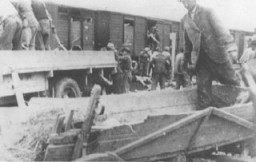
A hospital ward in Kielce after a postwar pogrom. Kielce, Poland, July 6, 1946.
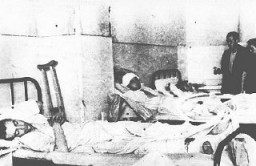
An American tank follows German civilians from Gardelegen who are marching to a barn just outside the town, where they will dig graves for over 1,000 prisoners killed by the SS inside the barn. April 18, 1945.

A woman mourns by the coffins of Jews who died in the Kielce pogrom. Poland, July 6, 1946.
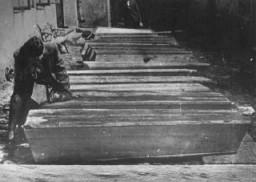
A Jewish youth on an agricultural training farm that prepared Jewish refugees for life in Palestine, sponsored by the Joint Distribution Committee. Fuerth, Germany, June 13, 1946.
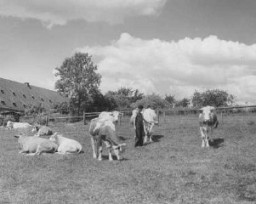
Jewish refugees in front of the "Kibbutz Buchenwald" building, where Jews received agricultural training in preparation for life in Palestine. Buchenwald displaced persons camp, Germany, ca. August 1946.
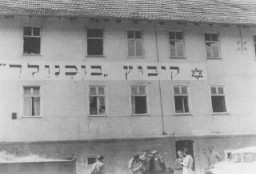
An agricultural training farm to prepare Jewish refugees for life in Palestine, sponsored by the Joint Distribution Committee. Fuerth, Germany, June 13, 1946.

Jewish refugees line up to receive food provided by the American Jewish Joint Distribution Committee (JDC) after the war. Shanghai, China, 1945-1946.
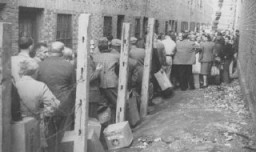
A US soldier tends to a former prisoner lying among corpses of victims at the Dora-Mittelbau concentration camp, near Nordhausen. Germany, after April 10, 1945.
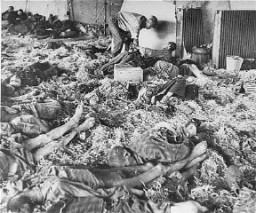
We would like to thank Crown Family Philanthropies, Abe and Ida Cooper Foundation, the Claims Conference, EVZ, and BMF for supporting the ongoing work to create content and resources for the Holocaust Encyclopedia. View the list of donor acknowledgement.